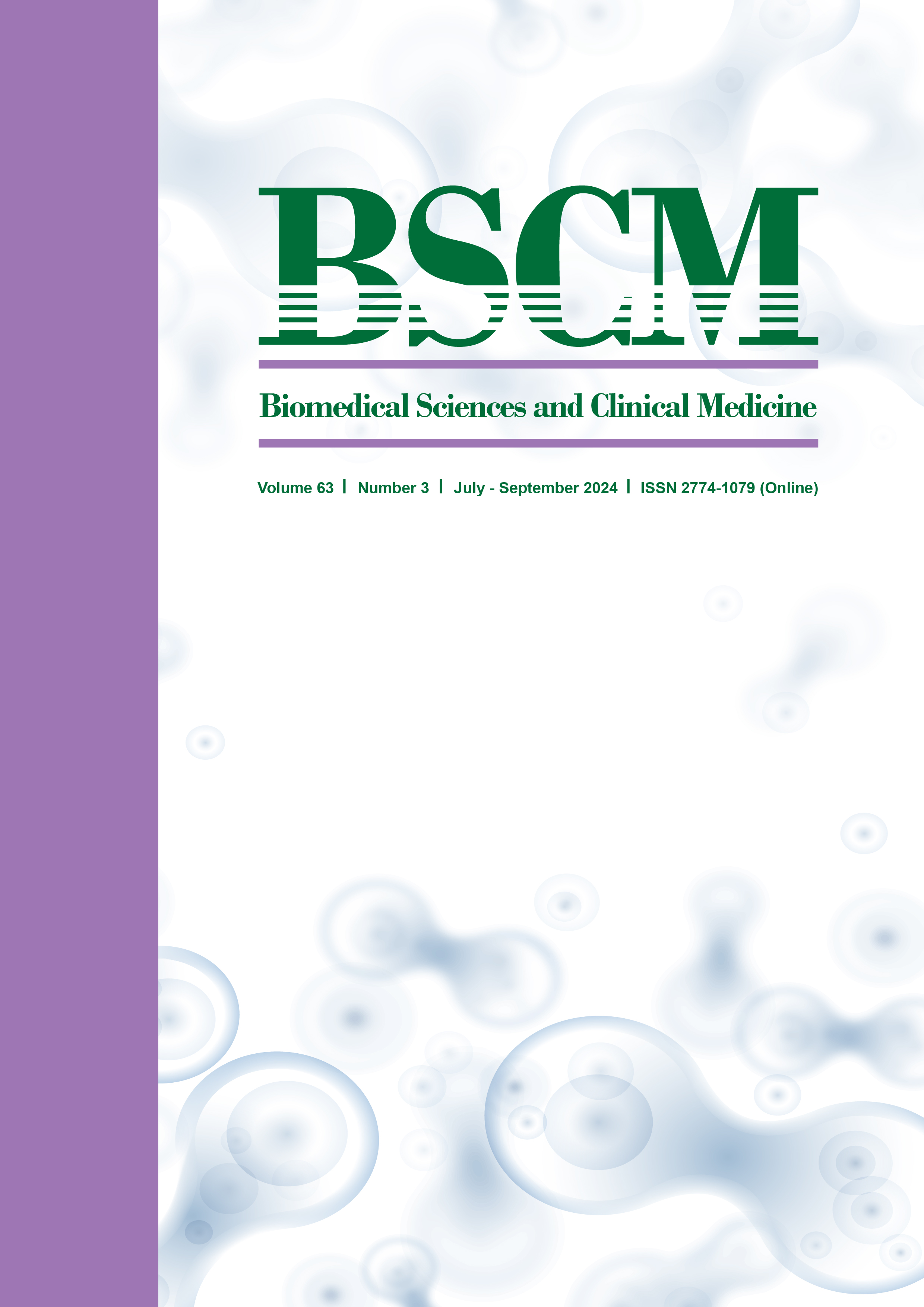Predictive Factors for Recurrence of Fistula-in-Ano After Surgery: A 10-year Experience in a Single Center Study
Main Article Content
Abstract
Objective This study aimed to evaluate the recurrence rate of fistula- in-ano treatment and factors associated with recurrence.
Methods A retrospective cohort study was performed of cryptoglandular-cause fistula-in-ano patients who underwent surgery between January 2010 and June 2020. Cox’s regression analysis was used to identify predictive factors for recurrence FIA.
Results The study included 282 patients of whom 233 (82.6%) were male, 76 (27.0%) had previous anal fistula surgery, 77 (27.3%) had a complex type of fistula, 72 (25.5%) were high transphincteric, 3 (1.0%) were suprasphincteric, and 2 (0.7%) were extrasphincteric. Five types of operations were performed: 106 (37.6%) fistulotomies, 43 (15.2%) fistulectomies, five (1.8%) setons, six (2.1%) endorectal advancement flaps (ERAF), and 122 (43.3%) ligations of the intersphincteric fistula tract (LIFT). The recurrence rate was 20.1% (57 patients) among whom 54 (94.0%) were detected at follow- up within 12 months, 2 patients were detected in the second year, and 1 patient was detected in the third year. Four independent factors associated with the recurrence of FIA after surgery were identified: female gender (HR 2.67; 95% CI 1.34-5.34), BMI >25 kg/m2 (HR 2.47; 95% CI 1.38-4.44), complex type of fistula (HR 2.02; 95% CI 1.02-3.97), and anterior opening (HR 2.14; 95% CI 1.12-4.10). Compared to the LIFT procedure, fistulotomy was the protective factor (HR 0.12; 95% CI 0.03-0.46) while ERAF had a higher rate of recurrence (HR 6.12; 95% CI 1.87-20.03).
Conclusions Patients with high BMI and female patients should be advised of the higher chance of recurrence after anal fistula surgery. More complex fistula-in-ano and sphincter-preserving surgery was also associated with a higher recurrence rate. The complete healing of the surgery should be monitored for two years after surgery.
Article Details

This work is licensed under a Creative Commons Attribution 4.0 International License.
References
Vogel J, Johnson E, Morris A, Paquette I, Saclarides T, Feingold D, Steele S. Clinical Practice Guideline for the Management of Anorectal Abscess, Fistula-in-Ano, and Rectovaginal Fistula. Dis Colon Rectum. 2016;59:1117-33.
Chadbunchachai W, Lohsiriwat V, Paonariang K. Long-term outcomes after anal fistula surgery: results from two university hospitals in Thailand. Ann Coloproctol. 2022;38:133-40.
Parks A, Gordon P, Hardcastle J. A classification of fistula-in-ano. Br J Surg. 1976;63:1-12.
Emile S, Elgendy H, Sakr A, Youssef M, Thabet W, Omar W, et al. Gender-based analysis of the characteristics and outcomes of surgery for anal fistula: analysis of more than 560 cases. Journal of Coloproctology. 2018;38:199-206.
Visscher A, Schuur D, Slooff R, Meijerink W, Deen-Molenaar C, Felt-Bersma R. Predictive factors for recurrence of cryptoglandular fistulae characterized by preoperative three-dimensional endoanal ultrasound. Colorectal Dis. 2016;18:503-9.
Emile SH. Recurrent anal fistulas: When, why, and how to manage? World J Clin Cases. 2020;8:1586-91.
Mei Z, Wang Q, Zhang Y, Liu P, Ge M, Du P, et al. Risk factors for recurrence after anal fistula surgery: A meta-analysis. Int J Surg. 2019;69:153-64.
Abbas M, Jackson C, Haigh P. Predictors of outcome for anal fistula surgery. Arch Surg. 2011;146:1011-6.
Hämäläinen K, Sainio P. Incidence of fistulas after drainage of acute anorectal abscesses. Dis Colon Rectum. 1998;41:1357-61.
Bakhtawar N, Usman M. Factors increasing the risk of recurrence in fistula-in-ano. Cureus. 2019;11:e4200. Pubmed PMID: 31114719
Sahnan K, Askari A, Adegbola S, Tozer P, Phillips R, Hart A, Faiz O. Natural history of anorectal sepsis. Br J Surg. 2017;104:1857-65.
Sanchez-Haro E, Vela E, Cleries M, Vela S, Tapiolas I, Troya J, et al. Clinical characterization of patients with anal fistula during follow-up of anorectal abscess: a large population-based study. Tech Coloproctol. 2023;27:897-907.
Amato A, Bottini C, De Nardi P, Giamundo P, Lauretta A, Realis Luc A, Piloni V. Evaluation and management of perianal abscess and anal fistula: SICCR position statement. Tech Coloproctol. 2020;24:127-43.
Koehler A, Risse-Schaaf A, Athanasiadis S. Treatment for horseshoe fistulas-in-ano with primary closure of the internal fistula opening: a clinical and manometric study. Dis Colon Rectum. 2004;47:1874-82.
Hamadani A, Haigh P, Liu I, Abbas M. Who is at risk for developing chronic anal fistula or recurrent anal sepsis after initial perianal abscess? Dis Colon Rectum. 2009;52:217-21.
Lu D, Lu L, Cao B, Li Y, Cao Y, Li Z, et al. Relationship between body mass index and recurrence/anal fistula formation following initial operation for anorectal abscess. Med Sci Monit. 2019;25:7942-50.
Schwandner O. Obesity is a negative predictor of success after surgery for complex anal fistula. BMC Gastroenterol. 2011;11:61.
Fazio VW. Complex anal fistulae. Gastroenterol Clin North Am. 1987;16:93-114.
Siddiqui M, Ashrafian H, Tozer P, Daulatzai N, Burling D, Hart A, et al. A Diagnostic accuracy meta-analysis of endoanal ultrasound and mri for perianal fistula assessment. Dis Colon Rectum. 2012;55:576-85.
Bubbers EJ, Cologne KG. Management of complex anal fistulas. Clin Colon Rectal Surg. 2016;29:43-9.
Malakorn S, Sammour T, Khomvilai S, Chowchankit I, Gunarasa S, Kanjanasilp P, et al. Ligation of intersphincteric fistula tract for fistula-in-ano: lessons learned from a decade of experience. Dis Colon Rectum. 2017;60:1065-70.
Bayrak M, Altintas Y. Predictive factors affecting recurrence of anal fistula after LIFT procedure. J Coll Physicians Surg Pak. 2022;32:1470-3.


